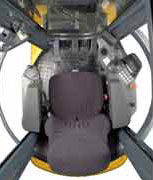 Jungheinrich's EFG D30 four-wheel electric forklift with air-cushioned seat. |
A European directive that sets limits for workers' exposure to equipment and work tool vibrations became law in European Union (EU) nations this year.
The seriousness of health risks from vibration exposure saw the EU draw up the 2002/44/EC vibrations guideline in June 2002 in Luxembourg. Jungheinrich trade press manager Jan-Abu Kaulfuhs told
Forkliftaction.com News the directive became national law in all EU countries this year.
The directive, which requires employers to assess vibration levels in workplaces to ensure limit values set by the EU are not exceeded, will be implemented in stages. Member states are allowed a five-year transitional period to comply before the regulations become fully binding.
Jungheinrich spokesperson Sebastian Riedmaier said employers were asking "how long can employees operate forklifts before they reach the exposure action value?" He said there was no standard answer to the question and individual workplaces had to be assessed by risk analysts.
"The vibration effect depends largely on factors like ground conditions and the type of application. The risk analysis must be carried out individually by employers at respective workplaces," Riedmaier said.
The directive establishes limits for two types of exposure - hand and arm vibration and whole body vibration. (
Forkliftaction.com News published a column in
Safety First by Dirk Zeinstra on hand and arm vibration last month.)
According to article 3 of the directive, the daily exposure action value for whole body vibration, using an eight-hour reference period, is 0.5m/s². When the value is reached, an employer must provide alternative work methods, ergonomic work tools and worker information and training to the employee.
If the daily exposure limit value of 1.15m/s² (eight-hour reference period) is exceeded, the worker must immediately stop working.
Whole body vibration is defined as the "mechanical vibration that, when transmitted to whole body, entails health and safety risks, in particular, lower-back morbidity and spine trauma".
Kaulfuhs said Jungheinrich had reacted to the vibrations guidelines before it became national law.
Since October 2005, all Jungheinrich's counterbalanced trucks have had new generation MSG 65 Grammer seats. The seat has a compact design and a "high level of cushioning".
Most Jungheinrich counterbalanced forklifts have a "floating cab", where the cab module is not rigidly screwed into place but positioned on damping elements that absorb impact that would otherwise be directed towards the cab.
Doosan Infracore Europe product support manager Patrick Goossens said field tests show Doosan forklifts complied with the new guidelines.
"[However], we are continuously working to reduce [vibration values] further through engineering and material choice of drivetrain mountings, seat design and engine choice.
"Forklift manufacturers are obliged to produce the best possible product but major contributors to vibration include operator techniques, surface conditions and equipment maintenance levels," Goossens said.
Forkliftaction.com News is interested to know about vibration guidelines in other world regions. Email www.forkliftaction.com to share your health and safety practices and guidelines or personal experiences.